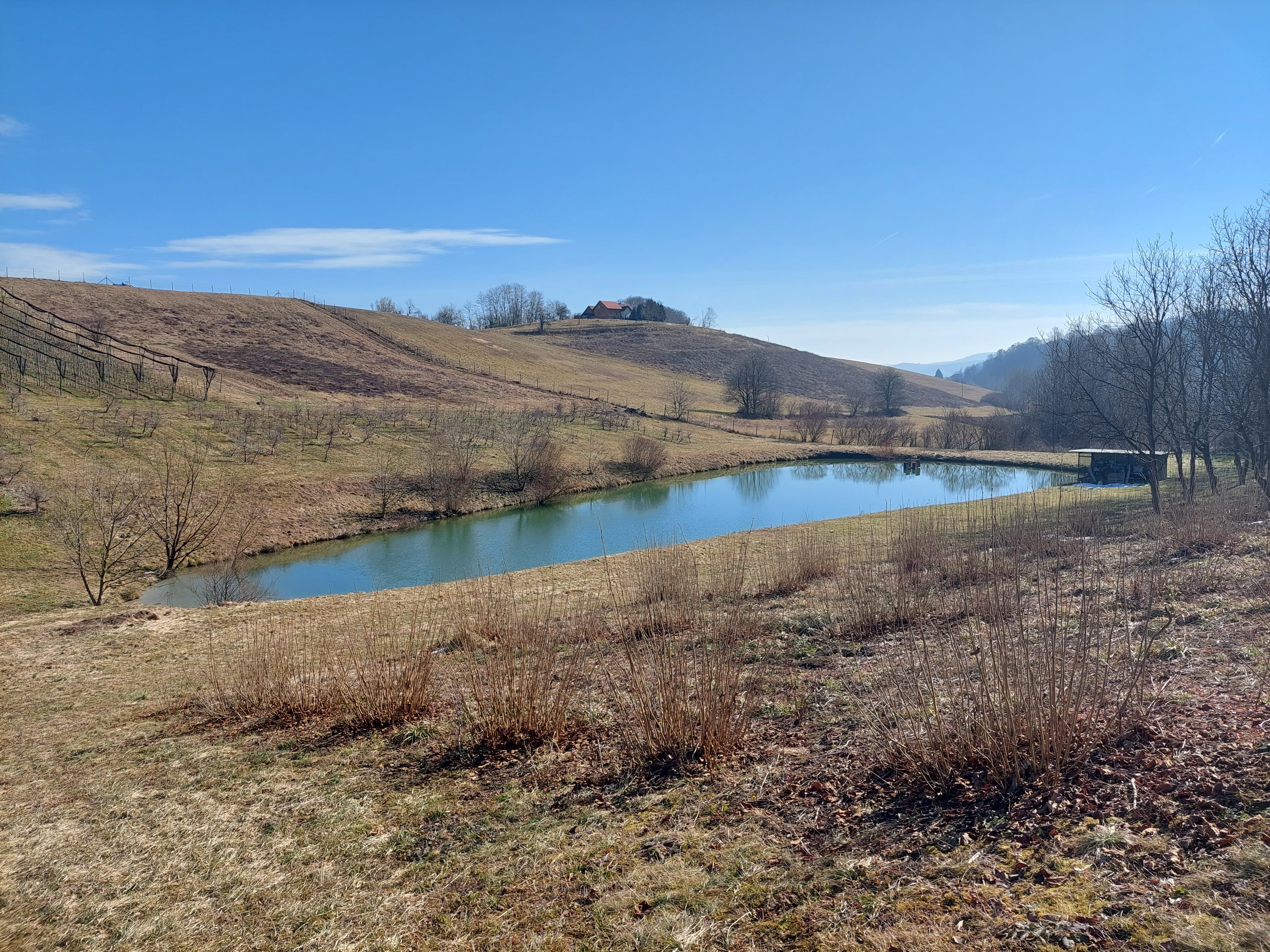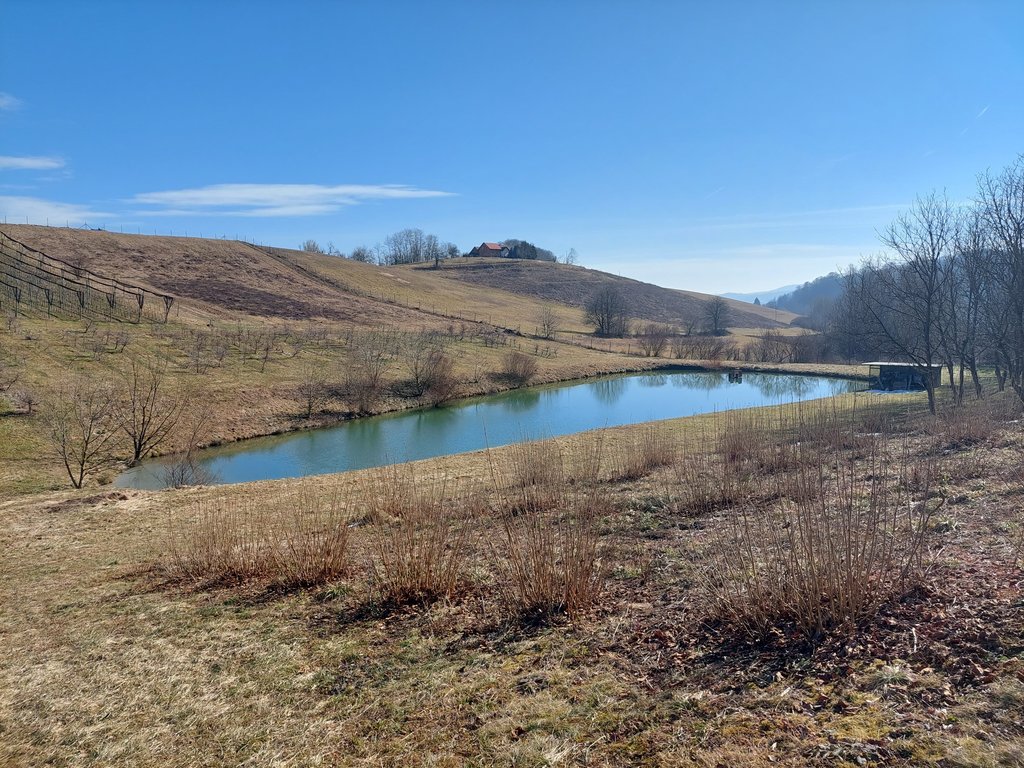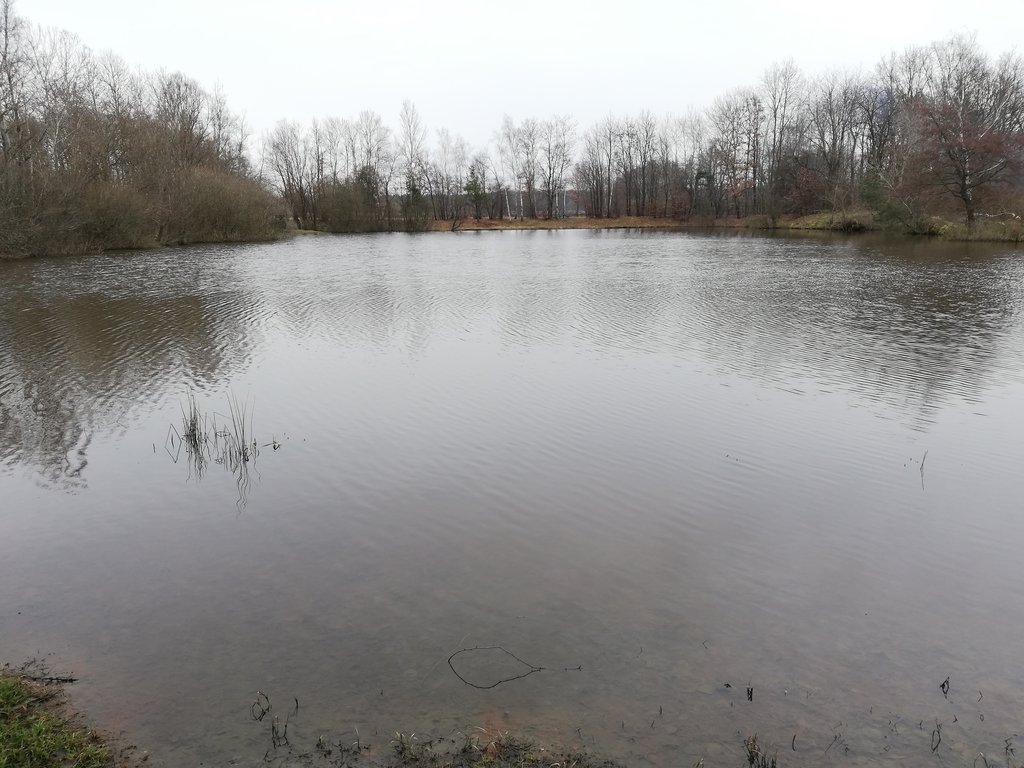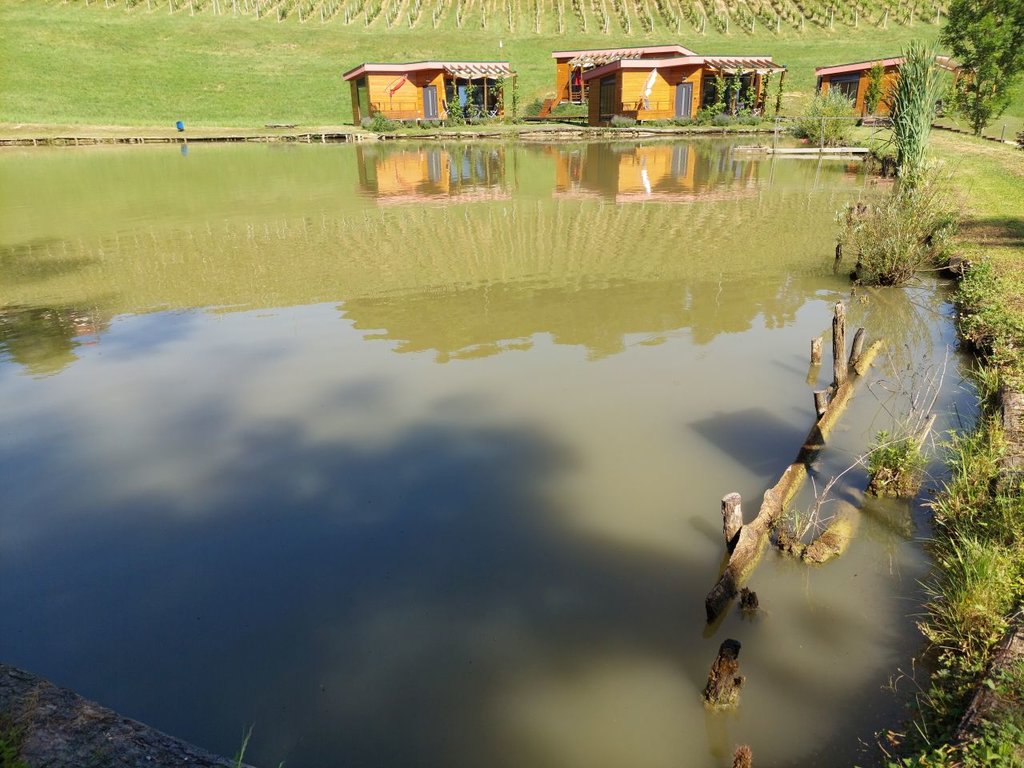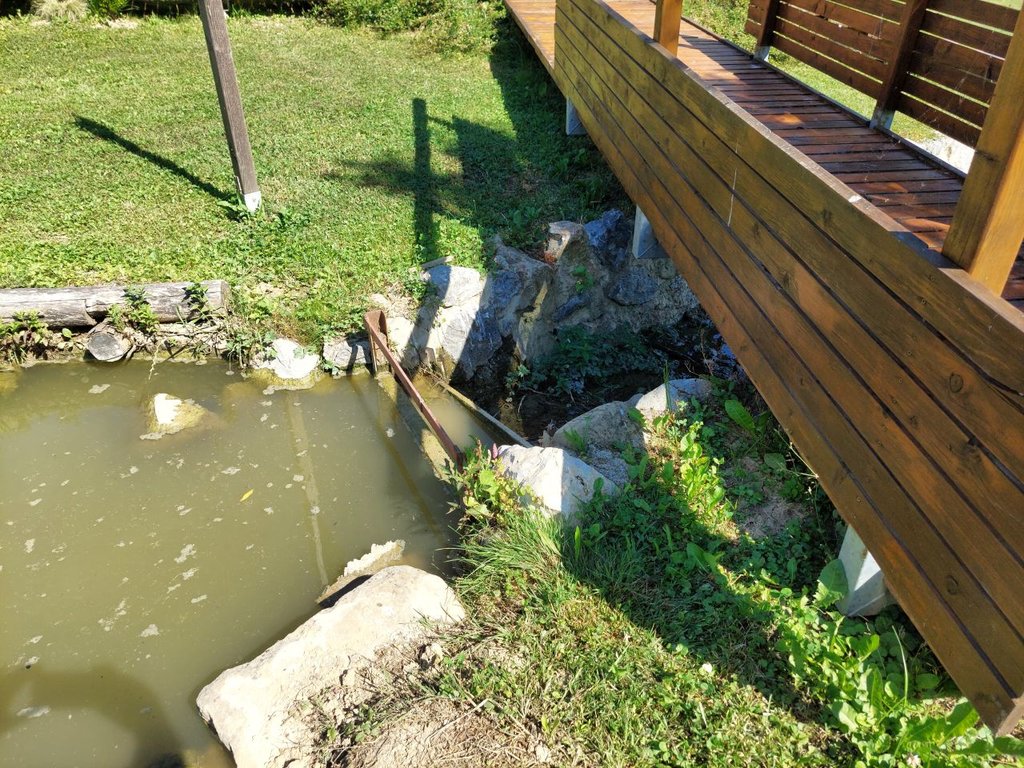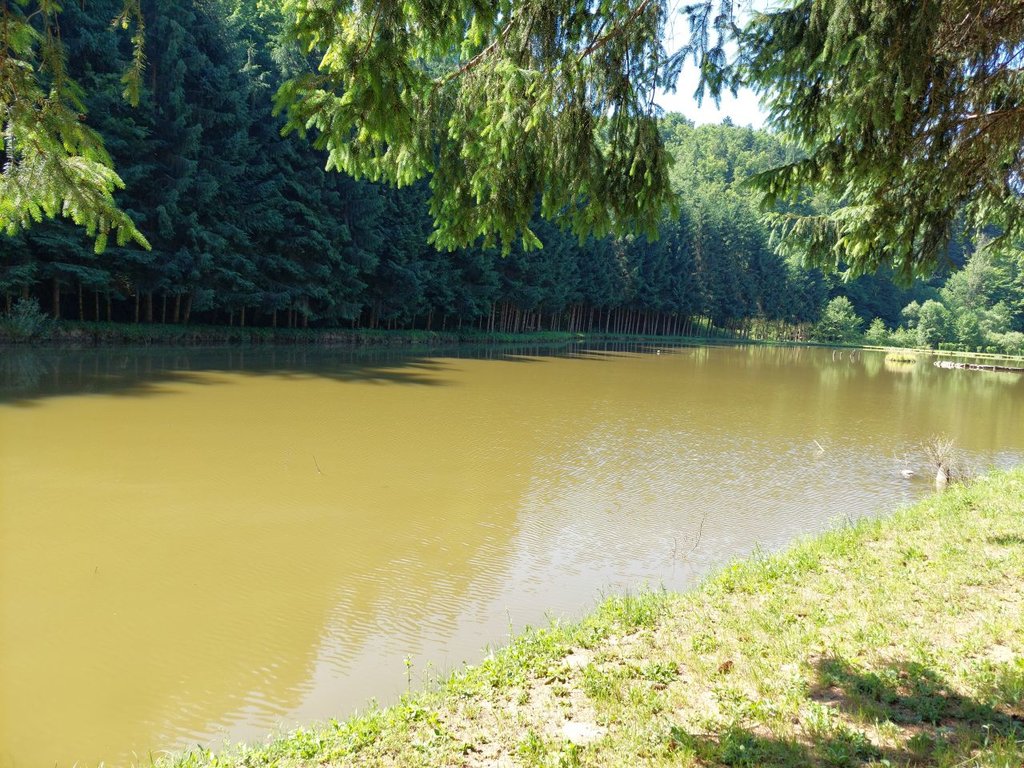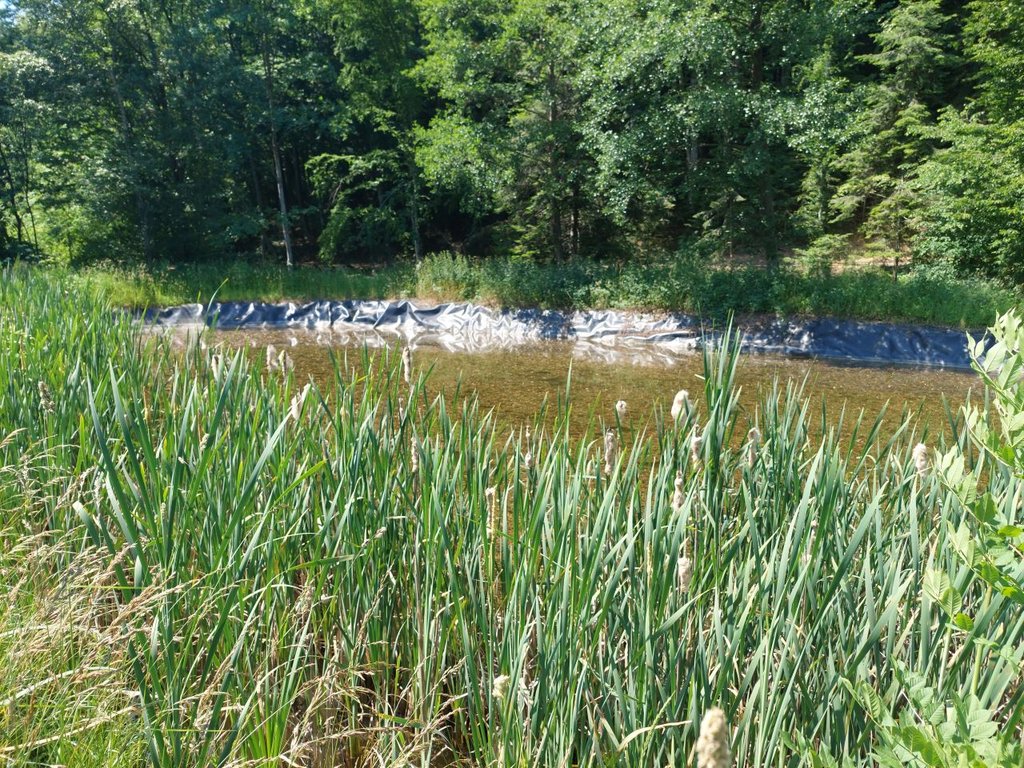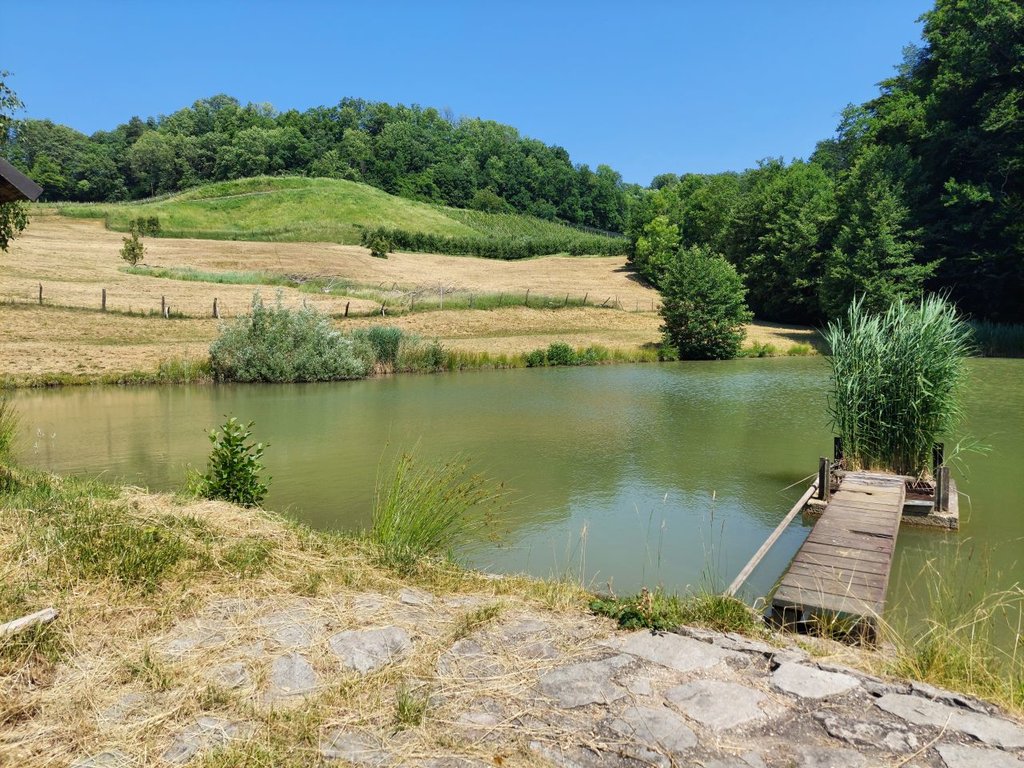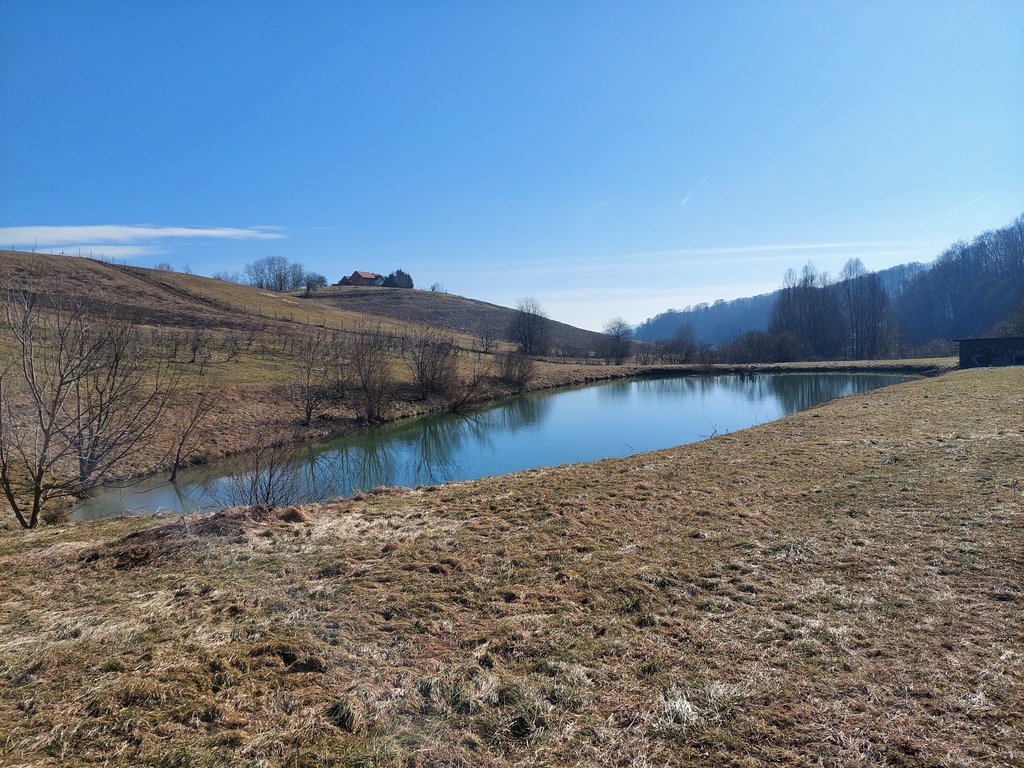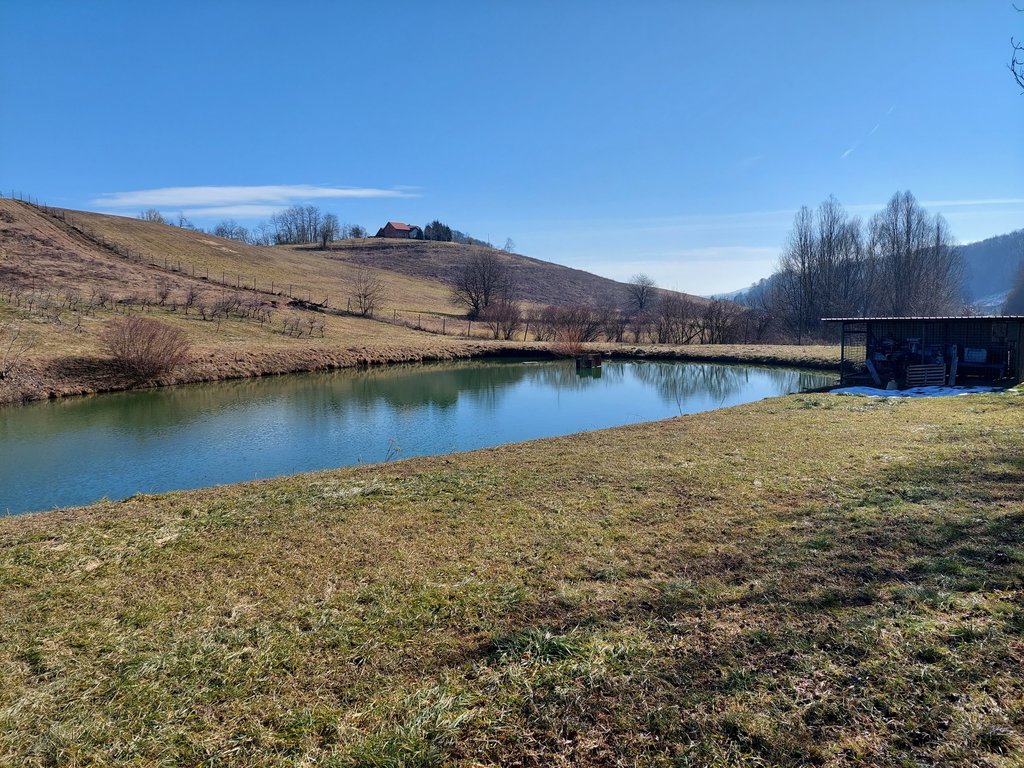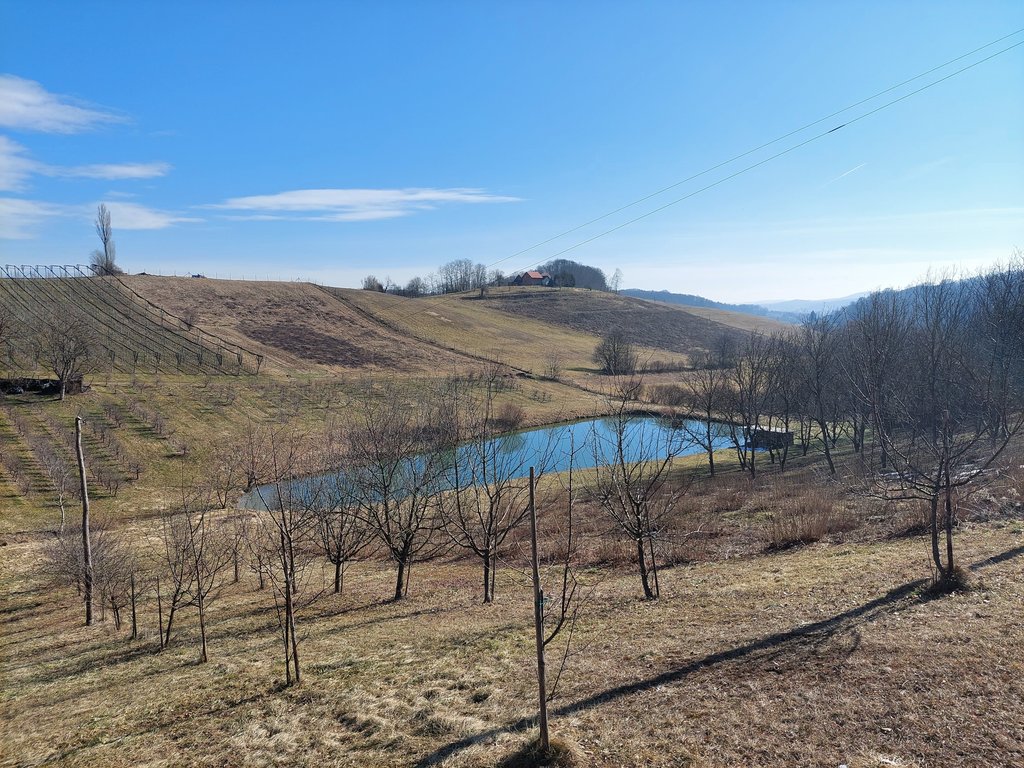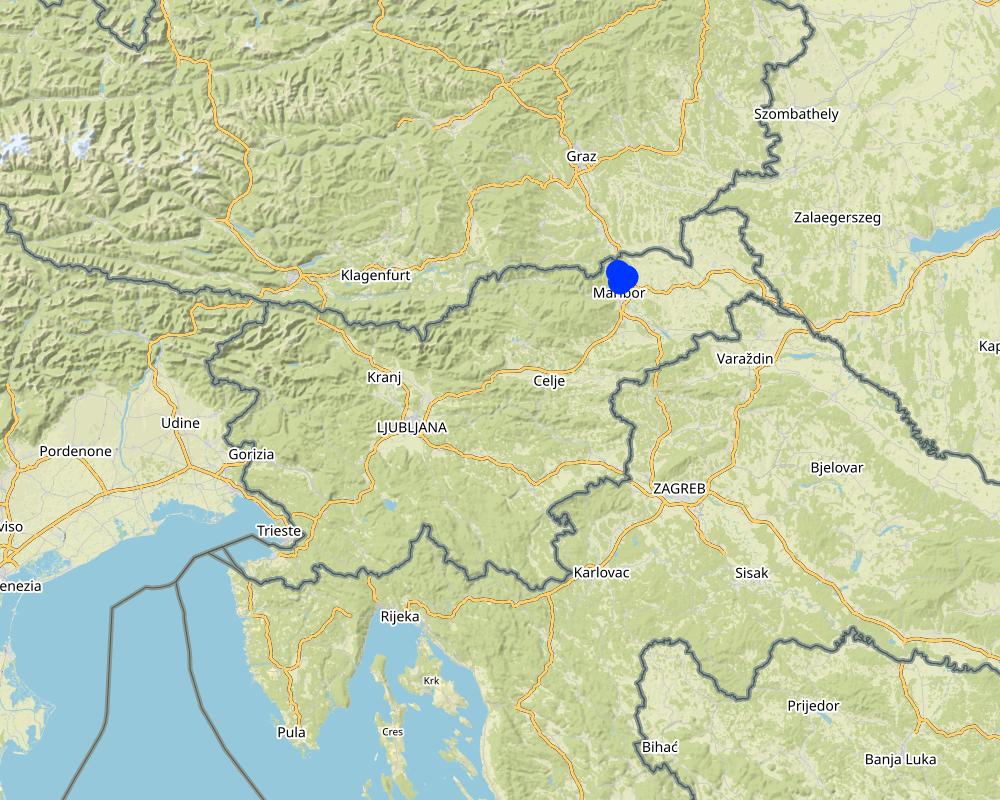Retention ponds [Eslovênia]
- Criação:
- Atualização:
- Compilador/a: Gregor Kramberger
- Editor: –
- Revisores: William Critchley, Rima Mekdaschi Studer
Mokri zadrževalniki vode
technologies_5933 - Eslovênia
Veja as seções
Expandir tudo Recolher tudo1. Informação geral
1.2 Detalhes do contato das pessoas capacitadas e instituições envolvidas na avaliação e documentação da tecnologia
Especialista em GST:
Especialista em GST:
Istenič Darja
Faculty of Civil and Geodetic Engineering, University of Ljubljana
Eslovênia
Especialista em GST:
Škerjanec Mateja
Faculty of Civil and Geodetic Engineering, University of Ljubljana
Eslovênia
Especialista em GST:
Banovec Primož
Faculty of Civil and Geodetic Engineering, University of Ljubljana
Eslovênia
Especialista em GST:
Curk Miha
Biotechnical Faculty, University of Ljubljana
Eslovênia
Especialista em GST:
Cvejić Rozalija
Biotechnical Faculty, University of Ljubljana
Eslovênia
usuário de terra:
Purgaj Donik Biserka
Fruit center Maribor (demonstrartion plantation centre), Institute of Agriculture and Forestry Maribor
Eslovênia
Nome do projeto que facilitou a documentação/avaliação da Tecnologia (se relevante)
OPtimal strategies to retAIN and re-use water and nutrients in small agricultural catchments across different soil-climatic regions in Europe (OPTAIN)Nome da(s) instituição(ões) que facilitou(ram) a documentação/ avaliação da Tecnologia (se relevante)
Chamber of Agriculture and Forestry of Slovenia – Institute of Agriculture and Forestry Maribor (KGZS) - EslovêniaNome da(s) instituição(ões) que facilitou(ram) a documentação/ avaliação da Tecnologia (se relevante)
University of Ljubljana (UL) - Eslovênia1.3 Condições em relação ao uso da informação documentada através de WOCAT
O/a compilador/a e a(s) pessoa(s) capacitada(s) aceitam as condições relativas ao uso de dados documentados através da WOCAT:
Sim
1.4 Declaração de sustentabilidade da tecnologia descrita
A tecnologia descrita aqui é problemática em relação a degradação da terra de forma que não pode ser declarada uma tecnologia de gestão sustentável de terra?
Não
Comentários:
With improper implementation and intended use, it can have a negative effect on sustainability in the environment. It can be sustainable if properly anticipated/planned. The construction of the pond is usually subject to an environmental impact assessment where these matters are resolved as to whether it is sustainable or not.
2. Descrição da tecnologia de GST
2.1 Descrição curta da tecnologia
Definição da tecnologia:
Retention ponds (e.g. flood storage reservoirs, shallow impoundments) are water bodies, storing water to attenuate surface runoff during rainfall events. They provide storage as well as improving water quality. Retention ponds may also be used for irrigation of farmland.
2.2 Descrição detalhada da tecnologia
Descrição:
“Retention ponds” comprise both simple, small ponds (up to 2000 m3, up to 4 m deep) and larger, more complex reservoirs (greater than 2000 m3). Retention ponds are designed to provide storage capacity to attenuate surface runoff during rainfall events. Each consists of a permanent ponded area with landscaped banks. Retention ponds achieve both storm water attenuation and water quality treatment through supplementary storage capacity of runoff. Water is then released at a controlled rate once the risk of flooding has passed. The technology can be applied in a natural or human environment. Before construction of a pond it is essential to follow legislation, which covers conditions and restrictions for the given location. Once a site is selected, technical documentation is prepared: first the conceptual design, then documentation for obtaining opinion, consent and a building permit. Later there is also project documentation for implementation. If the water is to be used for other purposes as well (e.g. for irrigation), it is necessary to plan for usage and environmental impact. Retention and still water promotes pollutant removal through sedimentation, while aquatic vegetation and biological uptake mechanisms offer additional treatment. Retention ponds are effective in removing urban pollutants and improving water quality.
They are created either by using an existing natural depression, or by excavating a new depression, or by constructing embankments. Existing natural water bodies should not be used however, due to the risk that pollution events and poorer water quality might disturb/damage the natural ecology of the system. A great benefit of retention ponds is that they hold water when there is an excess of it, which can be used later when water is not available (e.g. for irrigation). Irrigation users are farmers, so they see the advantage of using a retention system. In addition to irrigation, water has also been needed in recent years for anti-frost systems (sprinkling a consistent layer of water on the crop during an entire frost event until temperatures are back to safe levels). Disadvantages are mainly restrictions in some areas (e.g. protected areas), preparation of demanding documentation and bureaucracy, and lengthy procedures for obtaining permits.
2.3 Fotos da tecnologia
2.5 País/região/locais onde a tecnologia foi aplicada e que estão cobertos nesta avaliação
País:
Eslovênia
Região/Estado/Província:
Podravska region, Slovenia
Especificação adicional de localização:
Pesnica
Especifique a difusão da tecnologia:
- Aplicado em pontos específicos/concentrado numa pequena área
O(s) local(is) tecnológico(s) está(ão) localizado(s) em uma área permanentemente protegida?
Não
Comentários:
Setting up a measure in a protected area is limited and very difficult due to construction restrictions in such an environment.
Map
×2.6 Data da implementação
Caso o ano exato seja desconhecido, indique a data aproximada:
- 10-50 anos atrás
2.7 Introdução da tecnologia
Especifique como a tecnologia foi introduzida:
- Como parte do sistema tradicional (>50 anos)
- através de projetos/intervenções externas
Comentários (tipos de projeto, etc.):
In the 1990s, the state financed the construction of several water reservoirs in the area.
3. Classificação da tecnologia de GST
3.1 Principal/principais finalidade(s) da tecnologia
- Melhora a produção
- Protege uma bacia/zonas a jusante – em combinação com outra tecnologia
- Reduzir riscos de desastre
- Adaptar a mudanças climáticas/extremos e seus impactos
- Criar impacto econômico benéfico
3.2 Tipo(s) atualizado(s) de uso da terra onde a tecnologia foi aplicada
Uso do solo misturado dentro da mesma unidade de terra:
Não

Vias navegáveis, corpo d'água, zonas úmidas
- Lagos, represas
Principais produtos/serviços:
Retention of water, collection of water. Retention ponds are ponds or basins designed with additional storage capacity to attenuate surface runoff during rainfall events. In dry years, the water can be used for agriculture, e.g. for irrigation.
3.3 O uso do solo mudou devido à implementação da Tecnologia?
O uso do solo mudou devido à implementação da Tecnologia?
- Sim (Por favor, preencha as perguntas abaixo com relação ao uso do solo antes da implementação da Tecnologia)
Uso do solo misturado dentro da mesma unidade de terra:
Não

Vias navegáveis, corpo d'água, zonas úmidas
- Linhas de drenagem, vias navegáveis
- Pântanos, zonas úmidas
3.4 Abastecimento de água
Abastecimento de água para a terra na qual a tecnologia é aplicada:
- Precipitação natural
3.5 Grupo de GST ao qual pertence a tecnologia
- Coleta de água
- Gestão de irrigação (inclusive abastecimento de água, drenagem)
- Gestão de água de superfície (nascente, rio, lagos, mar)
3.6 Medidas de GST contendo a tecnologia

Medidas estruturais
- S5: Represa, bacia, lago
3.7 Principais tipos de degradação da terra abordados pela tecnologia

Erosão do solo pela água
- Wt: Perda do solo superficial/erosão de superfície
- Wg: Erosão por ravinas/ravinamento
- Wo: efeitos de degradação externa

Degradação biológica
- Bc: redução da cobertura vegetal
- Bh: perda dos habitats
- Bq: quantidade/ declínio da biomassa
- Bs: Qualidade e composição de espécies/declínio de diversidade
- Bp: aumento de pragas/doenças, perda de predadores

Degradação da água
- Ha: aridificação
- Hs: mudança na quantidade de água de superfície
- Hg: mudança no lençol freático/aquífero
- Hp: declínio da qualidade de água de superfície
- Hq: declínio da qualidade do lençol freático
3.8 Redução, prevenção ou recuperação da degradação do solo
Especifique o objetivo da tecnologia em relação a degradação da terra:
- Prevenir degradação do solo
Comentários:
To prevent erosion.
4. Especificações técnicas, implementação de atividades, entradas e custos
4.1 Desenho técnico da tecnologia
Especificações técnicas (relacionada ao desenho técnico):
Water retention pond – excavation scheme. R is the top radius of pond, while r is the base radius; h is the height and a refers to the bank slope. Storage volume is estimated by radius r and height h (Figure). We consider potential storage volumes of 5,000 m3 to 10,000 m3.
Prior to start of construction, detention/retention ponds should be designed by a registered design professional. Plans and specifications should be referred to by field personnel throughout the construction process. When placing a detention/retention pond in a space in the first phase it is necessary to produce a conceptual design of the intended construction of a pond, which must show the purpose and goals of the retaining wall, the size of the pond, the location, a list of plots that are encroached upon, distances from neighboring land and neighboring buildings, anticipated activities in the impoundment area, impoundment volume, barrier size data, including stability assessment, and geotechnical data (Hočuršćak 2017). When planning construction of the pond, attention should be paid primarily to the impact on the actual use of space from the point of view of water management regulations, which defines the area of use and activity restrictions, due to the possible negative impact on water and coastal lands, aquatic habitats and the ecosystem created by the construction of the reservoir. After talking with the designer, in order to obtain a water permit and consent from the authorities, it is necessary to prepare technical documentation for the installation and construction, which must also include the basis for monitoring operation and maintenance (Hočuršćak 2017). The technical documentation (dimensioning of the reservoir) may differ from the microlocation and purpose or use of the measure, e.g. if pool is intended only to contain high water, sediment or debris laoding, will it be inhabited by aquatic animals, will water be used for irrigation, drinking, etc. We also consider the shape and size of the area to identify those better suited for allocating ponds also in terms of space availability. For example, it is necessary to exclude locations with a greater slope and distance from the river considering higher slope and distance is more difficult and costly to construct. We also exclude locations where the construction of a pond is not possible because they are too narrow or too small. We should consider water retention ponds as elements of a green infrastructure network together with other natural elements (e.g. vegetated riparian zones) and protected areas (e.g. Natura, 2000 sites) with a pond design that embeds features that enhance their ecological functionality. These include mild-sloped sides with vegetated buffers along the shorelines and vegetated floating islands that facilitate the nesting of birds. We refer to excavated ponds, with no weirs or dams, since inline ponds are more costly and may have negative ecological impacts (A. Staccione et al. 2021).
Presentation of the water reservoir at the Sadjarski Center Maribor (translated: Fruit Growing Center Maribor):
The Sadjarski Center Maribor is located on a sloping terrain, which is pedologically and configuratively quite diverse, with slopes ranging from 5-15%. The soil structure is clayey loam with a basaltic substrate. In the lower, flatter part, the soil was waterlogged, which was resolved through drainage systems. These drains are directed towards a drainage ditch, which serves as the foundation for the pond and is fed by two smaller springs. The intake point is located at the lowest point and at the southernmost part of the complex. It covers an area of 3000 m2 and has a depth of up to 3.8 m. Its capacity is 5500 m3 of water when fully filled. At its southern part, there is a concrete overflow structure (spillway) with a height of 3.8 m, which is used to drain excess water and regulate the water level. A concrete pipe, 20 m in length and 80 cm in diameter, is connected to it for the discharge of excess water. On the western side, a concrete pumping platform with a canopy and an oil trap has been constructed. It houses a 185 kW (252 HP) DAF diesel generator and a Capprari flow pump with a capacity of 300 l/min (18.0 m3/h). The pumping unit is used for filling the reservoir of the irrigation fertigation system.
Autor:
A. Staccione et al.
Data:
2021
Especificações técnicas (relacionada ao desenho técnico):
Ponds should contain the following zones (NWRM.eu, retention ponds):
- a sediment forebay or other form of upstream pre-treatment system (i.e. as part of an upstream management train of sustainable drainage components),
- a permanent pool which will remain wet throughout the year and is the main treatment zone,
- a temporary storage volume for flood attenuation, created through landscaped banks to the permanent pool,
- a shallow zone or aquatic bench which is a shallow area along the edge of the permanent pool to support wetland planting, providing ecology, amenity and safety benefits.
Additional pond design features should include an emergency spillway for safe overflow when storage capacity is exceeded, maintenance access, a safety bench, and appropriate landscaping (NWRM.eu, retention ponds).
NWRM.eu, retention ponds suggest;
- The ratio of flow path length to width in the pond should be between 3:1 and 5:1. Inlets and outlets should be placed to maximise the flow path length through the pond.
- Ponds should be wedge-shaped in plan so flow enters the pond and gradually spreads out, improving the sedimentation process and potential improvement in water quality.
- The depth of the permanent pool should be between 1.2 m and 2.0 m. Deeper pools may be subject to stratification and anoxic conditions. Shallower pools may be prone to algal blooms and high biological activity during summer months.
- Side slopes should not be steeper than 1:3 to ensure public safety and maintenance access.
- Residence time of permanent pond should be at least 20 days to allow for biological treatment of dissolved pollutants where this is required.
- Additional storage volume drained in 24-72 hours after the rainfall event depending on the intensity and duration of the storm and the design specifications of the pond
- Outfall design should be such that at least 50% of the maximum storage volume is discharged within 24 hours to allow for multiple events
- Retention ponds should ideally be combined with upstream sustainable drainage components, such as smaller detention basins and swales, which offer primary treatment and sediment management.
- Regular inspection and maintenance is important for the effective operation of ponds as designed.
Regular maintenance activities include litter and debris removal; vegetation maintenance (including cutting of bank and aquatic vegetation and removal of nuisance plants); inlet/outlet inspection and maintenance; and sediment removal from forebay (where applicable). Less frequent maintenance may include sediment removal from permanent pond; repairs; ongoing inspections and monitoring.
Appropriate signage to warn of water depth must be included for public safety.
4.2 Informação geral em relação ao cálculo de entradas e custos
Especifique como custos e entradas foram calculados:
- Por unidade de tecnologia
Especifique a unidade:
pond
Especificar as dimensões da unidade (se for relevante):
5500
Outro/moeda nacional (especifique):
EUR
Se for relevante, indique a taxa de câmbio do USD para moeda local (por exemplo, 1 USD = 79,9 Real): 1 USD =:
0,97
Indique a média salarial da mão-de-obra contratada por dia:
90.90
4.3 Atividades de implantação
| Atividade | Periodicidade (estação do ano) | |
|---|---|---|
| 1. | Costs of obtaining construction, technical and project documentation | 1-2 years before before starting construction |
| 2. | Construction of a pond | 1st year |
| 3. | Costs of supervision of construction and craftsmanship | 1st year |
4.4 Custos e entradas necessárias para a implantação
Se você não conseguir discriminar os custos na tabela acima, forneça uma estimativa dos custos totais para estabelecer a Tecnologia:
73600,0
Se o usuário da terra arca com menos que 100% dos custos, indique quem cobre os custos remanescentes:
The construction of a water reservoir can be subsidized from various sources (EU, state, municipalities, etc.). The largest share of support can be obtained through the Rural Development Program, where an investment can receive support ranging from 30% to 50% of eligible project cost (establishment cost).
Comentários:
The costs include excavation costs and bottom waterproofing costs. Determining the exact establishment costs for the entire project was challenging due to variations in location, topography, size, shape, dimensions, materials, soil permeability, and other factors. The specific establishment cost for the retention pond at the case study location is not available or relevant, as it would be significantly lower than the cost of constructing such a pond today (due to inflation). Therefore, we decided to use projected values based on the maximum eligible costs set by the Ministry of Agriculture for grant applications, which amount to 13.38 €/m3 (2016). This value represents the justified project cost for constructing the retention pond. In this scenario, the estimated establishment cost for a typical 5000 m3 pond would be 66,900.00 €.
4.5 Atividades recorrentes/manutenção
| Atividade | Periodicidade/frequência | |
|---|---|---|
| 1. | Energy for pumping | annually |
| 2. | water fee | annually |
| 3. | Maintenance costs (vegetation management, inspections, infrastructure maintenance, mulching, invasive species removal, pumping the entire pond for cleaning and sediment removal, sludge cleaning, monitoring, bank stabilization, replacement of damaged parts, and sealing, etc.) | annually |
4.6 Custos e entradas necessárias pata a manutenção/atividades recorrentes (por ano)
Se você não conseguir discriminar os custos na tabela acima, forneça uma estimativa dos custos totais de manutenção da Tecnologia:
3000,0
Comentários:
Obtaining precise costs for maintaining the pond and its surroundings is challenging, as it involves various factors. The costs can include anything from labor hours and manual mowing around the pond to considering professionals for inspections, infrastructure maintenance, mulching, invasive species removal, pumping the entire reservoir for cleaning and sediment removal, sludge cleaning, monitoring, bank stabilization, replacement of damaged parts, sealing, and more. The exact costs are difficult to determine due to the highly diverse infrastructure present in different locations. We have estimated the costs per square meter of the area under maintenance, which includes both the surrounding land and the water surface. If it's only about cleaning the surroundings of the reservoir, we consider only the land area. However, if it involves cleaning within the reservoir, we also take into account the water surface area. The best rough estimates we have range from 1 to 5 € per square meter.
4.7 Fatores mais importantes que afetam os custos
Descreva os fatores mais determinantes que afetam os custos:
Construction costs are affected by the shape, size, depth and microlocation of the pond layout. In addition, the cost is also influenced by the purpose of use (e.g. if pool is intended only to contain high water, sediment or debris laoding, will it be inhabited by aquatic animals, will water be used for irrigation, drinking, etc.). Geomechanically conditions are also important, because ponds and reservoirs can affect slope stability and induce landslides. The value of the investment can vary greatly depending on the design of the pond, location, water content of the area, soil structure, climate conditions,... so it is impossible to determine the exact values for pond construction, but we can only give an estimation.
5. Ambiente natural e humano
5.1 Clima
Precipitação pluviométrica anual
- <250 mm
- 251-500 mm
- 501-750 mm
- 751-1.000 mm
- 1.001-1.500 mm
- 1.501-2.000 mm
- 2.001-3.000 mm
- 3.001-4.000 mm
- > 4.000 mm
Especifique a média pluviométrica anual em mm (se conhecida):
1080,00
Especificações/comentários sobre a pluviosidade:
The most precipitation falls in summer, the months with the highest average precipitation are June and August, the least precipitation falls in winter, in January and February at least, and in principle more precipitation falls in autumn than in spring.
Indique o nome da estação meteorológica de referência considerada:
Jareninski vrh (1981 – 2010)
Zona agroclimática
- Subúmido
Mean annual temperature in year 2014 Jareninski vrh is 11,9°C.
5.2 Topografia
Declividade média:
- Plano (0-2%)
- Suave ondulado (3-5%)
- Ondulado (6-10%)
- Moderadamente ondulado (11-15%)
- Forte ondulado (16-30%)
- Montanhoso (31-60%)
- Escarpado (>60%)
Formas de relevo:
- Planalto/planície
- Cumes
- Encosta de serra
- Encosta de morro
- Sopés
- Fundos de vale
Zona de altitude:
- 0-100 m s.n.m.
- 101-500 m s.n.m.
- 501-1.000 m s.n.m.
- 1.001-1.500 m s.n.m.
- 1.501-2.000 m s.n.m.
- 2.001-2.500 m s.n.m.
- 2.501-3.000 m s.n.m.
- 3.001-4.000 m s.n.m.
- > 4.000 m s.n.m.
Indique se a tecnologia é aplicada especificamente em:
- Posições côncavas
Comentários e outras especificações sobre a topografia:
There are depressions, settlements are in the valley, concave type.
5.3 Solos
Profundidade do solo em média:
- Muito raso (0-20 cm)
- Raso (21-50 cm)
- Moderadamente profundo (51-80 cm)
- Profundo (81-120 cm)
- Muito profundo (>120 cm)
Textura do solo (solo superficial):
- Médio (limoso, siltoso)
- Fino/pesado (argila)
Textura do solo (>20 cm abaixo da superfície):
- Médio (limoso, siltoso)
- Fino/pesado (argila)
Matéria orgânica do solo superficial:
- Médio (1-3%)
5.4 Disponibilidade e qualidade de água
Lençol freático:
5-50 m
Disponibilidade de água de superfície:
Bom
Qualidade da água (não tratada):
apenas para uso agrícola (irrigação)
A qualidade da água refere-se a:
água de superfície
A salinidade da água é um problema?
Não
Ocorre inundação da área?
Sim
Regularidade:
Esporadicamente
Comentários e outras especificações sobre a qualidade e a quantidade da água:
Hydro melioration was carried out in the area, a drainage system and water retention systems (e.g. ponds and basins) were arranged.
5.5 Biodiversidade
Diversidade de espécies:
- Médio
Diversidade de habitat:
- Médio
5.6 Características dos usuários da terra que utilizam a tecnologia
Sedentário ou nômade:
- Sedentário
Orientação de mercado do sistema de produção:
- Comercial/mercado
Rendimento não agrícola:
- 10-50% de toda renda
Nível relativo de riqueza:
- Média
Indivíduos ou grupos:
- Indivíduo/unidade familiar
- Empregado (empresa, governo)
Nível de mecanização:
- Mecanizado/motorizado
Gênero:
- Mulheres
- Homens
Idade dos usuários da terra:
- meia-idade
Indique outras características relevantes dos usuários da terra:
Manager of an agricultural company - fruit center - poblic demonstration plantation.
5.7 Área média de terrenos utilizados pelos usuários de terrenos que aplicam a Tecnologia
- < 0,5 ha
- 0,5-1 ha
- 1-2 ha
- 2-5 ha
- 5-15 ha
- 15-50 ha
- 50-100 ha
- 100-500 ha
- 500-1.000 ha
- 1.000-10.000 ha
- > 10.000 ha
É considerado pequena, média ou grande escala (referente ao contexto local)?
- Média escala
5.8 Propriedade de terra, direitos de uso da terra e de uso da água
Propriedade da terra:
- Empresa
Direitos do uso da terra:
- Indivíduo
Direitos do uso da água:
- Comunitário (organizado)
Os direitos de uso da terra são baseados em um sistema jurídico tradicional?
Não
Especifique:
They are based on national legal system
5.9 Acesso a serviços e infraestrutura
Saúde:
- Pobre
- Moderado
- Bom
Educação:
- Pobre
- Moderado
- Bom
Assistência técnica:
- Pobre
- Moderado
- Bom
Emprego (p. ex. não agrícola):
- Pobre
- Moderado
- Bom
Mercados:
- Pobre
- Moderado
- Bom
Energia:
- Pobre
- Moderado
- Bom
Vias e transporte:
- Pobre
- Moderado
- Bom
Água potável e saneamento:
- Pobre
- Moderado
- Bom
Serviços financeiros:
- Pobre
- Moderado
- Bom
6. Impactos e declarações finais
6.1 Impactos no local mostrados pela tecnologia
Impactos socioeconômicos
Produção
Produção agrícola
Comentários/especificar:
Irrigation has avoided reduction in production due to drought and frost
Qualidade da safra
Comentários/especificar:
Improved fruit health (protection against drought and frost)
Risco de falha de produção
Comentários/especificar:
Protection against drought and frost
Área de produção
Comentários/especificar:
Change of land use (from agricultural land to water body).
Gestão de terra
Comentários/especificar:
Increased the complexity of management.
Disponibilidade e qualidade de água
Qualidade da água para irrigação
Demanda por água para irrigação
Renda e custos
Rendimento agrícola
Comentários/especificar:
Production and income stability.
Diversidade de fontes de rendimento
Comentários/especificar:
Possible diversification on farm (tourism and recreation).
Carga de trabalho
Comentários/especificar:
Demanding maintenance and increased complexity of management.
Impactos socioculturais
Segurança alimentar/auto-suficiência
Comentários/especificar:
Lower risk of production failure, stability in business, motivation to do business in agriculture
Oportunidades de lazer
Comentários/especificar:
Possible additional activities on farm.
Instituições comunitárias
Comentários/especificar:
An example of good practice for the community.
Conhecimento de GST/ degradação da terra
Comentários/especificar:
With positive effects more interest of the farmer in sustainable production.
Impactos ecológicos
Ciclo hídrico/escoamento
Quantidade de água
Comentários/especificar:
Water available in dry months.
Colheita/recolhimento de água
Escoamento superficial
Drenagem de excesso de água
Evaporação
Solo
Umidade do solo
Comentários/especificar:
Increased in case of irrigation
Perda de solo
Ciclo e recarga de nutrientes
Biodiversidade: vegetação, animais
Cobertura vegetal
Diversidade vegetal
Comentários/especificar:
Planting species near/around the pond.
Espécies exóticas invasoras
Comentários/especificar:
Danger in case of improper maintenance.
Diversidade animal
Comentários/especificar:
For a green reservoir, a lot of green infrastructure is placed next to it, which serves as protection for animals and plants (beneficial).
Espécies benéficas
Diversidade de habitat
Clima e redução de riscos de desastre
Impactos da inundação
Deslizamentos de terra/fluxos de escombros
Impactos da seca
Risco de incêndio
Comentários/especificar:
Proximity to water.
Microclima
Comentários/especificar:
It affects the microclimate, more humidity, slower temperature fluctuations
6.2 Impactos externos mostrados pela tecnologia
Disponibilidade de água
Comentários/especificar:
It is slightly increased as the ponds provide water during dry periods.
Caudal confiável e estável em período seco
Comentários/especificar:
Improved mainly due to water retention during wet seasons for use in dry periods.
Cheias de jusante
Comentários/especificar:
Reduced due to the capacity of ponds to retain excess water during times when rivers may flood.
Sedimentação a jusante
Comentários/especificar:
The reservoir also enables sediment retention, preventing sediment from reaching downstream watercourses.
Poluição de água subterrânea/rio
Comentários/especificar:
Many studies indicate that ponds can trap harmful substances, causing them to settle or undergo processes (acting as natural purification systems, especially when appropriate plant species are involved). This helps maintain cleaner downstream flows in terms of pollutants.
Capacidade de tamponamento/filtragem
Comentários/especificar:
The pond's ability to retain pollutants also contributes to its buffering and filtering capacity.
6.3 Exposição e sensibilidade da tecnologia às mudanças climáticas graduais e extremos/desastres relacionados ao clima (conforme o ponto de vista dos usuários da terra)
Mudança climática gradual
Mudança climática gradual
| Estação do ano | aumento ou diminuição | Como a tecnologia lida com isso? | |
|---|---|---|---|
| Temperatura sazonal | verão | aumento | bem |
| Precipitação pluviométrica anual | redução/diminuição | muito bem | |
| Precipitação pluviométrica sazonal | primavera | aumento | muito bem |
Extremos (desastres) relacionados ao clima
Desastres meteorológicos
| Como a tecnologia lida com isso? | |
|---|---|
| Temporal local | bem |
Desastres climatológicos
| Como a tecnologia lida com isso? | |
|---|---|
| Onde de calor | não bem |
| Seca | muito bem |
Desastres hidrológicos
| Como a tecnologia lida com isso? | |
|---|---|
| Inundação geral (rio) | bem |
Outras consequências relacionadas ao clima
Outras consequências relacionadas ao clima
| Como a tecnologia lida com isso? | |
|---|---|
| Período de crescimento alogado | bem |
6.4 Análise do custo-benefício
Como os benefícios se comparam aos custos de implantação (do ponto de vista dos usuários da terra)?
Retornos a curto prazo:
neutro/balanceado
Retornos a longo prazo:
positivo
Como os benefícios se comparam aos custos recorrentes/de manutenção(do ponto de vista dos usuários da terra)?
Retornos a curto prazo:
positivo
Retornos a longo prazo:
positivo
Comentários:
The costs of establishing a retention pond are indeed very high, and it is a substantial investment. However, especially in the case of agricultural land irrigation, the benefits can be quite favorable, particularly in terms of drought protection or frost prevention. In the long run, the investment yields significant advantages, as it enables resilience to climate change. Farmers can also receive support through rural development programs, which provide 30-50% project funding. Although the maintenance costs can be considerable, they are necessary and offer substantial benefits to farmers who irrigate their crops or protect them from frost. From land users' perspective it's positive, if they have improved production results.
6.5 Adoção da tecnologia
- 1-10%
De todos aqueles que adotaram a Tecnologia, quantos o fizeram espontaneamente, ou seja, sem receber nenhum incentivo/ pagamento material?
- 0-10%
Comentários:
It is worth noting that the availability and extent of government subsidies can vary depending on the location, specific program, and eligibility criteria. In this research area, the majority of projects received partial funding from the government.
6.6 Adaptação
A tecnologia foi recentemente modificada para adaptar-se as condições variáveis?
Não
6.7 Pontos fortes/vantagens/oportunidades da tecnologia
| Pontos fortes/vantagens/oportunidades na visão do usuário da terra |
|---|
| Retention ponds are simple if space is provided. |
| They collect water for use in drought conditions. |
| Retention ponds manage storm water quantity and quality, lessening the transfer of pollutants and chemicals into nearby water bodies. |
| Improved storm water collection and flood control. |
| Retention ponds provide habitats for animals, organisms, and insects (biodiversity). |
| Pontos fortes/vantagens/oportunidades na visão do/a compilador/a ou de outra pessoa capacitada |
|---|
| Local farm water retention systems allow for the detainment of water captured during spring runoff as well as during precipitation events, either directly or due to transport by surface runoff. This provides water storage that can be drawn on when groundwater supplies become depleted. |
| Retention ponds are designed to hold excess storm water runoff and release it slowly to avoid flooding downstream areas. They also serve to reduce downstream peak flow and aid in retaining flood waters which reduces associated flood risks downstream. If water is released from the reservoir, they serve to replenish groundwater stores downstream. |
| Surface water retention systems have shown success in reducing nutrient and sediment loading in various locations worldwide. |
| Under drought conditions these systems enable farmers to draw water from the reservoirs to support crop irrigation. The main value of water retention ponds is related to agricultural water demand in the dry season. They are considered the only effective way to preserve agricultural productivity. The ponds can increase the monetary value of agricultural land that can cope with water needs. |
| In addition to the primary function of retaining high waters, they often also serve a multipurpose use, such as: supply of drinking water, irrigation of agricultural land, protection against erosion, aquaculture, fishing, energy source, preservation of landscape and biodiversity, tourism, recreation and others. |
| Biomass production is another benefit of multi-purpose surface water retention system – cattails bioproduction and nutrient management. |
| In the case of construction of the so-called of a "green" water reservoir, green infrastructure solutions can provide protection for various species of animals and plants, which promotes biodiversity. |
6.8 Pontos fracos, desvantagens/riscos da tecnologia e formas de superá-los
| Pontos fracos/desvantagens/riscos na visão do usuário da terra | Como eles podem ser superados? |
|---|---|
| Anaerobic conditions can occur without regular inflow. | Proper planning and dimensioning of the pond, location and water level are necessary. It is necessary to ensure adequate flow and depth of the pond. |
| May not be suitable for steep sites, due to requirement for high embankments. | The construction of the pond is planned at a suitable location. |
| Colonisation by invasive species could increase maintenance and pose a danger to cultivated areas. | Regular maintenance and cleaning of the pond bank is necessary. |
| Safety risk in case of slipping and falling into the pond. | It is necessary to fence and isolate the access to the pond. |
| Pontos fracos/vantagens/riscos na visão do/a compilador/a ou de outra pessoa capacitada | Como eles podem ser superados? |
|---|---|
| Large investments in the irrigation system and access to funds for irrigation infrastructure can be difficult to attain. | The size and holding capacity of retention systems also need to be considered to maximize benefits while limiting the initial costs of building a surface water retention system. |
| The construction requires a lot of technical preparation, planning, documentation and there are many bureaucratic obstacles to comply with the spatial acts of the municipality and to fulfil the requirements of the spatial planning authorities, which also includes large initial costs. | The preparation and management of the project should be entrusted to a professional service. Check the conditions ahead of time and plan strategically several years ahead. |
| While irrigation provides an economic gain during drought years, it also increases operational costs for water supplies. | Strategies need to provide drought proofing of crops as well as limiting damages caused by floods in non-drought years to reduce risk to farmers and the region. |
| Experts identified some barriers for greener pond implementation, especially related to reduced efficiency. The higher surface required can cause loss of water stored during summer from the higher rate of evaporation. Another risk is associated with vegetation close to the pond banks which can reduce impermeabilization and increase water infiltration due to root growth in the soil. | Good technical plan with solutions and compromises for best results with natural (green) benefits. Considering the benefits brought by green systems. |
| Unregulated relations between active/potential users, both in the delimitation of water rights, especially in times of water shortage, and in cases of regulating obligations for the proper operation and maintenance. | Collective investments with a good long-term plan for operation and maintenance. Organized management of users from the organization (e.g. municipality, etc.). |
7. Referências e links
7.1 Métodos/fontes de informação
- visitas de campo, pesquisas de campo
Field visit and conducted interview with the farm manager at the Fruit Growing Center Maribor. A working group was established, where we met 2 times to review and respond to the questionnaire.
- entrevistas com usuários de terras
Purgaj Donik Biserka is a farm manager of agriculture company "Fruit growing center Maribor" (land user).
- entrevistas com especialistas em GST
Matjaz Glavan, Istenič Darja, Škerjanec Mateja, Banovec Primož, Curk Miha and Cvejić Rozalija representatives from University of Ljubljana.
- compilação de relatórios e outra documentação existente
As for the literature, we utilized the following documents:
- Vodnogospodarske podlage za nadzor obratovanja in vzdrževanja manjših zadrževalnikov (translated: Hydraulic basis for monitoring the operation and maintenance of small reservoirs). Miljenko Hočuršćak. Aktualni projekti s področja upravljanja z vodami in urejanje voda. 28. Mišičev vodarski dan 2017.
- Natural water retention ponds for water management in agriculture: A potential scenario in Northern Italy; Andrea Staccione, Davide Broccoli, Paolo Mazzoli, Stefano Bagli, Jaroslav Mysiak; Journal of Environmental Management 292 (2021) 112849.
Quando os dados foram compilados (no campo)?
10/02/2023
7.2 Referências às publicações disponíveis
Título, autor, ano, ISBN:
An economic assessment of local farm multi-purpose surface water retention systems in a Canadian Prairie setting; Pamela Berry, Fuad Yassin, Kenneth Belcher, Karl-Erich Lindenschmidt, Appl Water Sci (2017) 7:4461–4478.
Disponível de onde? Custos?
Web
Título, autor, ano, ISBN:
Natural water retention ponds for water management in agriculture: A potential scenario in Northern Italy; Andrea Staccione, Davide Broccoli, Paolo Mazzoli, Stefano Bagli, Jaroslav Mysiak; Journal of Environmental Management 292 (2021) 112849.
Disponível de onde? Custos?
Web
Título, autor, ano, ISBN:
Natural Water Retention Measures; Report: Individual NWRM - Retention ponds.
Disponível de onde? Custos?
Web
Título, autor, ano, ISBN:
Vodnogospodarske podlage za nadzor obratovanja in vzdrževanja manjših zadrževalnikov. Miljenko Hočuršćak. Aktualni projekti s področja upravljanja z vodami in urejanje voda. 28. Mišičev vodarski dan 2017.
Disponível de onde? Custos?
Web
Links e módulos
Expandir tudo Recolher tudoLinks
Não há links
Módulos
Não há módulos


